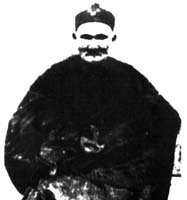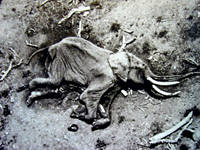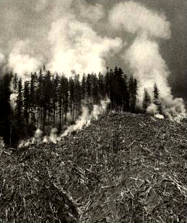|
|

|
||||||||||||||
|
|
Present Past Subjects Projects Misc |
JUNE 1999
Patron Saint of the Month Li Ching-Yuen The photograph and the account below are from a book that I have on taoist yoga, Muscle/Tendon Changing and Marrow/Brain Washing Chi Kungby Dr. Yang Jwing-Ming (1989). BTW: The 'official' title for the longest living human goes to a french woman, Mme. Calment, who died in 1997 at the age of 122 years. Her title may be contested. There was a report (05.09.98) that last year a man died in India at the age of 128... "Li Ching-Yuen was born in 1678 A.D. (Ching Kang Shi 17th Year) in Chyi Jiang Hsien, Szechuan province. Later he immigrated to Kai Hsien, Chen's family field (Chen Jia Charng). He died in 1928 A.D. at the age of 250 years. When he was 71 years old (1749 A.D., Chyan Long 14th Year), he joined the army of provincial Commander-in-Chief Yeuh Jong Chyi. Most of his wives died early, so during the course of his life he married fourteen times. "Li was a herbalist, and skilled in Chi Kung and spent much of his life in the mountain ranges. In 1927 General Yang Sen invited Li to his residence in Wann Hsien, Szechuan province, where a picture was taken of him. Li died the next year when he returned from this trip. "After he died, General Yang investigated Li's background to determine the truth of his story, and later wrote a report about him entitled: "A Factual Account of the 250 Year-Old Good-Luck Man" (Er Bae Wuu Shyr Suey Ren Ruey Shyr Jih), which was published by the Chinese and Foreign Literature Storehouse (Jong Wai Wen Kuh), Taipei, Taiwan. "All of the information available indicates the story is true. Li Ching-Yuen's legacy to us is the fact that it is possible for a human being to live more than 200 years if he or she knows how. Because of this we deeply believe that, if we humbly study and research, the day will come when everyone will live at least 200 years." FYI (cultural perspective): In 1678 Vivaldi was born and John Bunyan published Pilgrims Progress. A page offered up by Google reports that the monk Li, Ching-Yuen died at the age of 256 according to an article published in the New York Times on Saturday May 6, 1933 (pg.13). Old, Older, Oldest Folklore and Mythology Electronic Texts (external link) is a fantastic resource of folktales and links, thematically organized with Aarne-Thompson type numbers which has been compiled, edited and translated by D. L. Ashliman. Here's a page of folktales (external link) of Aarne-Thompson type 726 about old men, their fathers, and their grandfathers. Eduardo Kac Received an email from Eduardo Kac (external link) inviting me to contribute an article on Good and Evil on the Long Voyage (1997) to a special issue of the Irish contemporary art magazine CIRCA (external link) that he is currently preparing. Vacation Approach 1 June always felt like a special day when I was a kid. I remember walking to high school and dreaming about the approaching vacation. I still feel it is as a good day for new resolutions as 1 January. Here's the Alamut entry for this day last year. Christmas in June Some of my books on order arrived while I was in Groningen (Tuesday/Wednesday). From Proxis: Neal Stephenson's latest. (I'm saving this for the vacation. I keep having this fantasy of cracking open the 1st of the 900+ pages just as the airplane taxis away from the pier...) From Powell's: 'Naven', Bateson's first book, 'A Sacred Unity: Further Steps to An Ecology of Mind', a second collection of Bateson's essays and scientific papers, published posthumously, and Tyler Volk's 'Metapatterns'. Jouke and the boys are safe and sound back in Burgundy. Between thundershowers and power failures it sounds like he's stewing about the last week's 'Sites and Situations' workshop. I quote: 'Public Art and Design' offer an escape into institutional-conceptual legitimation for those artists that suffer a lack of wild talent. Domestication is what results. Blank looks. Interestingly enough I heard similar sounds (in different words) yesterday from fellow panelist Renée Kool. And I concur with both of them. Here's a few notes that I myself scribbled last Friday evening:
After last Saturday I feel that using art education to address 'society' and the 'social' is really quite wicked. As JK put it: 'Domestication is what results'. What a problem for the serious student! Schizophrenia mea culpa. Li Ching-Yuen's Garden I bought 19 large specimens of Sempervivum this afternoon and potted them on my terrace in terracotta bowls. I chose the plants for their aesthetics as 'rock plants', for their visual aspect and for their hardiness. After I was done, I was a bit shocked to realise that the latin 'semper' means forever and 'vivo' means to live, refering to plants that seem to live forever. But then again, it makes a great deal of sense if you consider this month's patron saint. Semiotics — Memetics I'm curious about the relationship between visual perception (and the 'affordances' offered by an image) and the parasitic, virus-like replication of memes. There is not a thought in our heads that has not been worn shiny by other brains. CONSIDER this image:
EXEGESIS:
Whoops Looks like my pastiche of Oldenburg (yesterday's 'I'm for an art...' vitriol) hit a patch of sensitive skin. I'm sorry. Seriously sorry. I didn't mean to hurt or confuse anyone. If you were at the conference Saturday and any of my remarks bother you, please realise that the conference I attended was different from the conference you attended... It is well known that email and news posts (and web logs) afford much opportunity for schismogenesis. Odd, isn't it, how the cold war 'hotline' between the White House and the Kremlin (once representing an immediate person to person call/appeal to moderation and domestication) has mutated into too cool electronic forms that are very often incendiary? Hot and cold media (and the difference between notebooks and diaries): 28.05.99. I'm for an art that moves forward rather than backward. Does the above statement represent a dichotomy or a binary? Is there a difference between the two? Dichotomies: True and False WordNet 1.6 (external link) lists 2 senses of the noun 'dichotomy':
And 1 sense for the noun 'binary':
And 2 senses for the adjective 'binary':
If I had to differentiate between a dichotomy and a binary, I'd emphasize the 'classifying' aspect of the word 'dichotomy' and the 'whole-system' aspect of the word 'binary'. Dichotomies are man-made. Binaries are made in heaven. Whether of not a dichotomy is TRUE or FALSE depends on the terminology (map) of the taxonomist and his or her talent as a classifier.
THE BINARY As defined above, a binary is a system consisting of two units or components or elements or terms. A binary system's two parts can be opposed but they can never be mutually exclusive. Binaries are dynamic. To the binary, the taxonomist is an observer. Prehuman, Human, Posthuman I'm for an art that moves forward rather than backward. So what's forward?
Forward Backword Example A dialogue between Dave Foreman, founder of Earth First! and Frederick Turner, advocate of Mars colonization, in Tyler Volk's book, Metapatterns: DF: Our environmental problems originate in the hubris of imagining ourselves as the central nervous system or the brain of nature. We're not the brain, we are a cancer on nature. FT: If we are a cancer, then I am for it. ... The nervous system is a glorious cancer that has evolved, and I stand with it. I am that cancer. DF: And I am the antibody. Alamut context: The Shallow and the Deep, the 'Deep Ecology' manifesto by Arne Naess. In lieu of a meeting in one of Media-GN's air-tight offices, Stefan and I went out for a falafel and a cup of coffee this afternoon. We talked about his performance over the weekend, the concept of finite and infinite games, Gertrude Stein, Flann O'Brien's footnotes, the novels of Beckett, and John Cage's essay on silence. It stopped raining long enough for us to sit outside. The girl at the falafel bar showed me her new shoes. One Small Suprising Thought Later, while thinking about our conversation and searching for an example of an event horizon and the existence of a logic completely outside of our current 'system' or logic, (the idea of system or logic is defined here as behaviour "cognitively consistent with the behaviour (and perceptions) of all other individuals in all other contexts"), I was completely dumbstruck by the idea that the buddhist notion of 'enlightment' (and its implications) would provide precisely such an example. Enlightment makes a perfect singularity! New lines of thinking radiate from one small surprising thought. Yeah, yeah, yeah, yeah! This morning I spent some time twitching and tweaking last Saturday's note. It was pretty convoluted. Sorry about that. I hope it reads a bit easier now. Around 2, I went to the market and collected three more plant species for the Li Ching-Yuen Memorial Garden: some grey 'Leontopodium', some grey-green 'Lavandula' and some yellow 'Sedum acre'. Mike Tyler arrived after 4, bearing A. E. van Vogt's 'The World of Null-A' (1945) and 'The Players of Null-A' (1948), two long-out-of-print mass paperback SF novels based upon Korzybski's General Semantics. Extremely pulp covers and backs. The World of Null-A bears an ink stamp on the first page: Siskiyou General Hospital Auxiliary. (Google tells me) that Siskiyou is in Yreka, CA. I wonder what it was like to read this book there? (Both books were bought by Mike on his recent trip to California.) Mike: "The farther you head out into the desert the more SF you find in the used book shops..." We ate dinner together at the Hotel New York. As usual the whelks (and that other small dark shellfish that I don't know the english name for) were delicious. Site Here and there. In 1992 I participated in a public art project for the Dutch town of Oosterhout. The brief to the artists asked for a representation of the town's identity. In order to do this, I found it necessary to ignore the site entirely. After a cursory first visit I found it was essential that I DID NOT RETURN THERE... "In addition, it seems a pointless exercise to have to hunt for 'public space' wandering within the boundaries of Oosterhout's streets. I do not want to look for some specific physical feature or activity and transform it into an excuse in which to evolve a work. I feel this would be taking the first step in the wrong direction." This evening I discovered that Ruth Benedict's classic anthropological study of Japan 'The Chrysanthemum and the Sword' (1946), was written without her ever having visited that country. Benedict gathered material for her monograph from her readings of Japanese life and interviews with Japanese immigrants. Her findings were rejected by the Japanese because she did not study them first hand. Ironically, much of her work has since been validated (Bock 1982). Sites and Situations Reflecting on the recent 'Sites and Situations' workshop on public art, I am reminded of the late Timothy Leary's terms for site and situation: 'set and setting'. Philip H. Farber in 'Psychedelics and the Art of Ritual' explains: In the early 1960s, while studying the effects of psychedelics, Timothy Leary and colleagues proposed the idea of 'set and setting' as crucial factors in the psychedelic experience. Leary: "Set refers to that which the subject brings to the situation, his earlier imprinting, his learning, his temperament, his emotional, ethical and rational predilections and, perhaps most important, his immediate expectations about the drug experience." Leary: "Setting refers to the environment, social, physical, emotional, to the milieu of the session. This most important aspect of setting is the behavior, understanding and empathy of the person or persons who first administer the drug and who remain with the taker for the period that the drug is in effect." One of Leary and company's more interesting studies along these lines (interesting, at least, for the subject at hand) is the 'Good Friday' study. The study involved 20 divinity students, half of whom were given 30mg. of psilocybin, the effects of which were experienced during a devotional service in a private chapel on Good Friday. A placebo was distributed to the remainder of the students, with neither subjects nor experimenters knowing who received which preparation. The majority of those receiving the psychedelic experienced mystical states of high quality, supporting the hypothesis that psychedelics in combination with intentionally prepared set and setting can produce quite specific results. Art is definitely a drug. And there is definitely something we can learn from seriously studying it as such. MYOB I've been accused of setting up false dichotomies in the hurried manifesto/Claes Oldenburg pastiche that I published on June 3rd. Article 2 of the aforementioned manifesto stated: I'm for an art that mind's its own business and does not try to solve the world's problems, the commissioner's problems or the problems of the commissioner's 'tenants'. Why did I say this? I'd argue that artists tend to be 'outsiders', are distinguished/determined by that fact, and should stay that way. Art made by artists reflects some of that quality of 'outsideness'. Art is attractive to others precisely because it is different, revealing signs of a non-conventional (or alien) logic, opening doors to 'a separate reality'. Convential idea. Yeah, I know. But I haven't always felt this way. For years I've maintained that the unknown individual painting their heart out in their zolderkamer or garret, was no artist. I said that art and artist are created in a cultural context and under cultural conditions. In the world. Now I'm not so sure. Findagrave.com Findagrave.com (external link) is yet another extraordinary net database. It turned up this morning while doing a google search for Cordwainer Smith (Paul Myron Anthony Linebarger), cult SF writer and author of one of the 20th centuries most important books on psychological warfare. To do a search for someone and be offered a view of their grave is, to say the least, interesting, and affords a rather singular way to learn more about someone... ...that is if they are not one of the 'unwashed' and unremembered masses. Alamut context: See the George Orwell quote and entry for 'Good Friday' (02.04.99): "They riseout of the earth, they sweat and starve for a few years, and then they sink back into the nameless mounds of the graveyard and nobody notices that they are gone. And even the graves themselves soon fade back into the soil. Sometimes, out for a walk, as you break your way through the prickly pear, you notice that it is rather bumpy underfoot, and only a certain regularity in the bumps tells you that you are walking over skeletons." And even if they are remembered, how many are remembered for long? Quote from A. E. van Vogt, 'The World of Null-A' (1945): "After death, the body disintegrated; the personality survived as a series of distorted impulse-memories in other people's nervous systems. As the years flew by, those memories would grow dimmer. At most, Gilbert Gosseyn would survive as a nerve impulse in other human beings for half a century; as an emulsion on a film negative for several score years; as an electric pattern in a series of cathode ray cells for perhaps two centuries." Think: (1) placeholder for an photo of the enormous collection of human bones that Aernout Mik and I collected from a 'dump' (was that in the fall of 1985?) (2) James Lovelock's essay Immortal Media. Findagrave.com was created by one Jim Tipton. BTW: I've created a separate index of the graves from Tipton's database that I visited and found in one way or the other interesting and worth returning to. Absolute favorites (all external links): Constatin Brancusi
AWOL I've been very staunch and steadfast in avoiding my work (things I'm obligated to do but don't feel like doing) the last couple of days. No need to explain. This happens from time to time. I just wish I didn't feel so guilty and stressed about it. Discussing childhood books with Mike Tyler the other evening I recalled going through a period as a kid when I read every 'escape' books that I could find. Escape from Alcatraz, escape from WW-II camps, every book in library over Houdini... Mike: "I wonder what that meant?" Here's a thought: Avoidance is not nearly as satisfying as a well executed escape. Exactly one year ago today I found a book that offered a modern (though frankly not very satisfying) solution to the problem: 'How to Disappear Completely and Never be Found'. There must be better ways to escape than just disappearing. Who was it that said, 'I love it when a plan comes together'? (This is not a rhetorical question...) Harry Houdini
A couple of interesting books have been published over the last couple of years on the life, times and psychology of Mr. Houdini: The Life and Many Deaths of Harry Houdini by Ruth Brandon (1993) Houdini!!! The Career of Ehrich Weiss by Kenneth Silverman (1996) Robinson Wizard's Universal Electric site has a number of very tasteful Houdini pages (external link). From the article 'Harry Houdini By Harry Houdini' published in The Magician Annual (London 1909-1910): 'Robert-Houdin Unmasked' is a book that will live long after we are all dead, will stand as a monument of years of diligent research and endeavor, and will bring me back to the minds of the public when I am long forgotten as a public performer. Question: If you were to create a Houdini memorial garden, which plants would you use? Alamut Mail Could someone please help with a translation here? Thanks. Me gustaría recibir información sobre el ismailismo nizarita: historia, filosofía y sobre todo información sobre lo que les ocurrió tras la invasión mongola. Recibir un afectuoso. Saludo. Combat Botany... ...is a real discipline. Honest. I was on a mailing list once which had a member who was a 'combat botanist'. He worked for the U.S. army. And if you search hard enough you'll find that the North American Combat Botany institute is at the University of Virginia... Methuselah... ... was the oldest man in the bible (Genesis chapter 5 verses 25-27):
Prometheus In 1964, a graduate student cut down the oldest living tree, a bristlecone pine (Pinus longaeva, Pinus aristata) in order to count its rings: "Late in the year of 1964 a young geographer, Donald R. Currey, a student at this university, who was working toward his doctorate, was in the Southwest searching for evidence of Ice Age glaciers. The Wheeler Peak glacier and related phenomena attracted him. When this student and his associate came upon the bristlecones at the timberline, they began to take core samples from several trees, discovering one to be over 4,000 years old! Needless to say they were excited, and at some point, their only coring tool broke. The end of the field season was nearing. They asked for (and I still can't believe it!) were granted permission by the U.S. Forest Service to cut the tree down. The tree was 'Prometheus'. "After cutting the trunk at a convenient level, which happened to be more than eight feet above the original base, 4,844 rings were counted. This student had just killed the oldest living thing on earth! Eventually, dendrochronologists determined the tree to be 4,950 years of age." Prof. Donald R. Currey's home page today (external link) at the University of Utah. The Old Man of the Mountains Brian Ness at About.com describes the natural history of the bristlecone pine: "... the Bristlecone Pine lives in one of the harshest environments in the mountains of the Southwest. They live at elevations of close to 12,000 feet (3,620 m.) in locations that receive only about 12 inches (30 cm.) of precipitation per year, mostly as snow. They are continually battered by gale-force winds and their growing season is little more than several weeks. As if these disadvantages were not enough, they live on some of the poorest mountain soils (e.g. dolomite). "To survive these harsh conditions and live to such tremendously old ages, the Bristlecone Pine has a number of unique adaptations. They have particularly long-lived needles that remain on the trees for decades, especially in areas with the poorest soils. Their wood is very dense and extremely resistant to insects and other pests. They grow very slowly to conserve metabolic reserves. Lastly, they often maintain only a small amount of living tissue. This last adaptation is what makes them look like they are dead or nearly so. Often the bark of the trees is confined to a few narrow strips and the needles are only found on the ends of some of the larger branches." Links and Sources: Trees Older Than Methuselah (About.com)
(This month's patron saint is Li Ching-Yuen.) The Ability to Sustain A couple of months ago I was invited to participate in a project concerning 'sustainability'. The initiative came from Josette Jacobs, a PhD candidate of the department of Applied Philosophy at the University of Wageningen. Josette wrote a proposal in which she suggested augmenting her doctoral thesis with an artwork and found support for this idea at the NUON, one of the largest energy distribution agencies in the Netherlands. I've been invited, as the artist, to join a project team consisting of herself, her colleague and mentor Bart Gremmen and representatives of the NUON. We had a meeting this afternoon in Arnhem, and I was up bright and early to prepare for it. Josette sent me a note Friday with a question for the meeting: In which way are industry, art and science concerned with sustainability? To illustrate her question she included a citation from Gadamer which I've had translated (thanks Gabrielle, Stefan, Marten and Jente...) "... Dass an einem Kunstwerk Warheit erfarhren wird, die uns auf keinem anderen Wege erreichbar ist, macht die philosophische Bedeutung der Kunst aus, die sich gegen jedes Rasonnement behaupted..." "That an artwork makes it possible to experience truth, which we cannot reach in any other way, constitutes the philosophical importance of art, which stands up to all notions of reason." Sustainability is a hot and complicated term, one that I'm afraid implies a lot of nasty assumptions and prejuidices. (When Josette first called me about the project, I told her that if she wanted a 'sustainability artist' she was calling the wrong number.) Why? The word, IMHO, is much too fashionable and politically correct for its own good and in most cases the 'need for sustainability' is automatically assumed without clearly looking at what is in danger of not being sustained... To illustrate this I can point to a fair amount of Alamut context:
Questions Josette's question was: In which way are industry, art and science concerned with sustainability? To which I added my own two questions: (1) Are the terms 'industry', 'art', 'science' and 'sustainability' categories or functions? (2) Are they mutually exclusive and objective (well defined) 'classes of things' or do they represent positions, points of view or stations in a large state space (or world model)? Personally I see the first three terms (industry, art, science) as reflecting more or less stable 'points of view.' The last term, sustainability, I see as reflecting the ability (skill, art) to sustain the state space (or world model) itself. Answers SUSTAINABILITY FROM THE PERSPECTIVE OF INDUSTRY: Where industry is 'organized man', the working system, structures and patterns of material flow and energy harnessed, the creation of wealth and further flow... Sustainability is seen either as (1) a threat to the existing ways of doing things requiring a change in operating procedure or (2) as a new business opportunity, the chance to exploit a new niche... SUSTAINABILITY FROM THE PERSPECTIVE OF ART: Where art is 'emergent magic', the manipulation of signs, the map that exposes new territory, the entry point and the escape route... Unfortunately, if art is paying attention at all, it usually finds itself playing the conscience of society, the conscience of earth and our future, and it produces (more often than not) propaganda rather than art. Art(ists) can not observe the threat to 'sustainability' directly and thus is dependent upon the observations of others and/or confused by the media's views. Greenpeace does better propaganda. SUSTAINABILITY FROM THE PERSPECTIVE OF SCIENCE: Where science is 'measuring man', the sense's ratio, the questioning of cause and effect, the map maker, the record keeper... Looking at sustainability science asks, (1) 'What is sustainability?' and (2) searches both the archive of memory-knowledge and the state space (world model) for answers to this question and (3) looks for solutions to the questions from industry. Gadamer Josette's citation of Gadamer slightly confuses me. I'm not sure what Gadamer means by truth. I understand the citation to mean: The artwork can model and exemplify the complexity of a given state (subject). It can reveal patterns, afford graspability, offer entry points and escape routes between the myriad possibilities available in a way that rationality never can. It can even allow (afford) the possibility of going 'beyond' the horizon of the system space itself... Simply: (through the artwork) experience is no longer sustained but transcended. Click your heels 3 times and repeat after me: 'Take Me Away From All This Death'. Garden Books Garden books. My god there are a lot of garden books. This morning Amazon lists 6,715 books for the word 'Garden', 9,047 books for the word 'Gardening' and 12,764 books for the word 'Plants'. And to think that I've been compiling my own modest list... Valley Book A new book about the Valley Gold Rush which compares favorably to 'Microserfs'? On Slashdot, John Katz has reviewed (external link) Po Bronsen's new book: 'Nudist on the Late Shift'. "The Sub-35 billionaire is really a new life-form" writes Bronson, "an economic mutation that emerged from this little pond of vigorous capitalist Darwinism. It's as if dinosaurs suddenly hatched again in the Alviso mudflats off San Jose..." Garden Talk My friend Norman Olsen used the wonderful phrase 'zone denial' on the phone last night while talking about the Vancouver habit of attempting to cultivate California plants. (For those who do not know: gardening regions worldwide are classified into the 'climatic zones' 1 to 12, and all plants, trees and shrubs are born with a little label attached to their stems that let the gardener know where and when they can be used...) Another note: Norman described a group of forest plants called 'ephemeral plants' as candidates for a potential 'Houdini' garden. Would these be the logical opposite of longevitous plants? The mayflies under the flowers? Is this useful? A glossary of the latin roots of botanical names database (external link). Stuck in time in the prisonhouse of language. I learned enough about an old hermeneuticist, Hans-Georg Gadamer (who was born on the 11th of February 1900 and as far as I 'understand' is still alive), yesterday to become intrigued. During our meeting, Josette Jacobs made a couple of preposterous* 'according to Gadamer' statements namely: (1) 'predjudice is positive' (in respect to understanding) and (2) 'we can make good use of confusion'... Gadamer is unfortunately not listed in the 'Cambridge Dictionary of Philosophy' but there appears to be several good web resources explaining his theories of understanding. One site, The Hans-Georg Gadamer Home Page (external link) is concise and contains a number of good links, one of which, 'Hermeneutics, stuck in time in the prisonhouse of language' (external link), begins with the story of Billy Pilgrim attempting to explain the concept of time to the Tralfamadorians in Slaughterhouse Five and then follows up with a number of Gadamer aphorisms culled from his major work: Truth and Method (Wahrheit und Methode. 1960). Josette found yesterday's 'That an artwork makes it possible to experience truth' citation in W & M. Here's a few more:
You know reading this set of aphorisms I've just got to think of Korzybski ('The map is not the territory'), Cultural relativism (Sapir-Whorf), and Bandler and Grinder's NLP. Alamut context: (15.02.99), (20.02.99), (21.02.99), (26.02.99) etc. and for a brief introduction to Korzybski: Paul Dennithorne Johnston's 'What is General Semantics' (external link).
*one definition of preposterous is 'contrary to nature, reason or common sense' A word is dead
Emily Dickinson. Poems. Book I. Life. (1896).
I found out this morning that the husband of Josette Jacobs died Tuesday in a vehicle accident. Stasis In a conversation the other day, someone (I can't remember who) made a distinction between a state of standstill and a state of stability. I'm still thinking about it. Whoever you were, thank you. Progress Or as JK said (on June 15th): "History never repeats itself. Gottesdank." A whole new way to think about publishing: genetic cryptologists have found a way to encode textual information in 'human' DNA. DNA encryption (external link). More information about the first CLONED human embryo (external link). "...the development of the technology makes the eventual birth of a human clone inevitable. This, opponents say, would have profound implications for the nature of family relationships, the law and health." Went to the Netherlands Architecture Institute for a presentation of the DataWolk Hoeksche Waard (external link), translation: Data Cloud Hoeksche Waard, a navigation system for an online database of objects relating to the past, present and future of this large rural area south of Rotterdam. The overall concept is somewhat redolent (IMHO) of the some of the work of Knowbotic Research (external link), and as such it shares the fact that I found the interface extremely obtuse and confusing. YMMV. UPSTAIRS: Installed 2 wooden trellises in the Li Ching-Yuen Memorial Garden. DOWNSTAIRS: Repotted my collection of Lophora williamsii (15 specimens, the oldest 12 years old).
Equations Spent this year's halfway point billing people for services rendered but not yet paid for and writing things down that I'm not yet ready to publish. The Geometry of Collaboration (A dutch film crew is making a movie around my building.) About a year ago, Rijk van Kooij, one of my students, added me to his six-degrees list (external link). I registered, added a few names of my own and began to receive mail and information about the project. After a short time I lost interest, liking the idea but feeling somehow that the community was too BIG (the theory: each person in the world is connected (known) to each other person through a maximum of six intermediaries). Apparently the mathematicians have been playing this game for a while with a measurement called an Erdös number (external link) and drawings that they call collaboration graphs: "Most practicing mathematicians are familiar with the definition of one's Erdös number. Paul Erdös, the late widely-traveled and incredibly prolific Hungarian mathematician of the highest caliber, wrote hundreds of mathematical research papers in many different areas, many in collaboration with others. His Erdös number is 0. His co-authors have Erdös number 1. People other than Erdös who have written a joint paper with someone with Erdös number 1 but not with Erdös have Erdös number 2, and so on. If there is no chain of co-authorships connecting someone with Erdös, then that person's Erdös number is said to be infinite.
"In graph-theoretic terms, the collaboration graph C has all mathematicians as its vertices; the vertex p is Paul Erdös. There is an edge between u and v if u and v have published at least one mathematics article together. The Erdös number of v, then, is the distance (of the shortest path) in C from v to p. The set of all mathematicians with a finite Erdös number is called the Erdös component of C. Clearly, any two people with a finite Erdös number can be connected by a string of co-authorships, of length at most the sum of their Erdös numbers." Doe, Jane et al. Collaboration can be physical or memetic (think: mental mononucleosis). I'm interested in learning more about collaboration affordances and dynamics. Someone once told me that there is often a lot of 'tension' over the order in which names are listed at the top of an academic paper. Given "the cheapest way to propagate ideas (or reputations) is by address", this makes sense, for usually when a paper is referenced by other papers only the first few author names are given (followed by that infamous black hole of abbreviation, 'et al.'). Limbo 6:00 A.M. browsing, looking up books on patterns, updating my pattern bibliography, wondering whether I should go to a yet another meeting of the 'Amsterdam 2.0' project this afternoon. (I love the limbo of the early morning hours, when the sun shines and the earth is still. The only sign of life out the window: one hundred tiny flies float peaceably in the still air.)
Notebooks Searching, I came across an entry for D'Arcy Wentworth Thompson's 1917 classic, 'On Growth and Form' in one of Cosma Rohilla Shalizi's notebooks (external link). I haven't had much time to check these notebooks out other than admiring their sprawling coverage of all-things-interesting. Should Alamut develop in a similar manner? BTW: Sunday evening I found that Portland Oregon's Powell's Bookstore (external link) finally had a copy in of Bateson's 'Mind and Nature' which I immediately ordered, along with Stewart Chase's 'The Tyranny of Words' (an early popularization of General Semantics), and a copy of 'On Growth and Form'. Finished Finished reading Van Vogt's two Null-A novels which Mike Tyler lent me. (Alamut context: 11.03.99, 8.06.99, 10.06.99.) They've certainly acted as proselytizers for General Semantics since the 1950's but SF literature they are not. A last quote (from the Players of Null-A): 'The galaxy,' he said, 'swarms with anarchistic ideas, but I've never before heard of them working. I've been trying to figure out how this Null-A stuff operates, but it seems to depend on people being sensible, and that I refuse to believe.' Gosseyn said nothing more. For this was sanity itself that was being discussed, and that could not be explained with words alone. If Janasen was interested, let him go to the elementary schools... Also: I haven't bought Wired this month. The last year or two I've been picking it up purely out of habit. I've been buying it since the first issue in March 1993. In this, Li Ching-Yuen's longeval month there has been some dying. Both Josette Jacobs' husband and Peter Giele, the artist, died last week and on Monday night a party commemorating Giele in Amsterdam's Roxy nightclub got a bit out of hand (fireworks) and the place burned down. The End of the World A poem by Archibald MacLeish (1892-1982): Quite unexpectedly, as Vasserot
And there, there overhead, there hung over
Given (in its heyday) that the Roxy (external link) was the epitome of Amsterdam decadence, it is amazing how well MacLeish's poem fits Monday's circumstance. Onward. Public Private I'm intrigued with how lemonyellow.com (external link) blends a public discussion of design issues and links to interesting papers such as: 'Swift and Abbott's Use of Geometric Imagery to Dissect Their Worlds' (external link) with private talk. An isolated out-of-the-blue lemonyellow entry on the 21st of June: "Evidently, I didn't say what you wanted to hear." brings an existential spatio-temporal edge to today's weblog-notebook. See also JK's pleasurable trepidation concerning what to publish and what not: (08.03.99). Food and drug administration: pizzas, tonics and natural sleeping aids. DIY Excellent Fast Food I'm totally convinced that we ate the world's best pizza last Saturday evening. Here's the recipe:
Unbelievable. Hydrocotyle asiatica Read last night about Hydrocotyle asiatica otherwise known as Centella asiatica or Gotu Kola (Indian pennywort). Daniel Reid in his 'A Handbook of Chinese Herbs' (1995) describes gota kola as a longevity tonic amongst Himalayan and Taoist hermits and in passing references this month's patron saint: The Chinese herbalist Li Ching-Yuen, who is reported to have died in 1933 at the age of 256, recommended it above all other herbs for prolonging life, and the famous Hindu guru Nanddo Narian revealed it to be his secret elixer at the age of 107. Valeriana officinalis Speaking of tonics, when you are worn out life is a bitch. And although you probably haven't noticed, I'm wearing a lot thinner than ususal. How come? The end of the school year? Maybe. In the case of our school at Media-GN, it's the end of the school 'two years' as we accept new students only once every two years and the present group is about to graduate. I'll certainly miss everyone. Love is a puppy that grows up and says goodbye. Alternative self diagnosis: These are the closing days of a particular cycle of my life. The bitter end as it were. Going out T. S. Eliot style (see the last lines of the 'Hollow Men'): This is the way the world ends
In any case I don't get enough sleep so the last few days I've been dosing myself with 300 mg of valerian extract (external link) before going to bed, and getting a record (for me) of about 6 hours a night. It seems to help. Or is it just that a change is as good as a rest? Yesterday I went to Media-GN (the MFA exams are in less than 2 weeks!) Today my body went to Minerva (to the year-end-critique of the work of the 3rd year media students) but my head stayed where it was yesterday. Afterwards, I got on the train and stared out the window for 3 hours. At home, I ate pasta with L. and read Borges' Garden of Forking Paths. It bears repeating: 'The cheapest way to propagate ideas is by address.' I told Jente and she told me that it sounded like an excellent definition of knowledge management. Perl Hacked Community Databases It would have been so much better and more interesting IMO if the V2 - AIR Data Cloud project (18.06.99) had made use of Slashdot's everything.com model (external link). It would have been richer, more fun and more intuitive and have saved months of development time... the source of everything.com is open. I Take It All Back Talk about the definitive disclaimer... Just noticed the note JK has added to his sidebar for Notes Quotes Provocations and Other Fair Use (external link). NOTE: generally corrections are made
This is how we use the web, publish first and correct (or perish) later. The Garden of Forking Paths I told Stefan about the book that I saw (William Poundstone's 'Labyrinths of Reason') that had a chapter linking the labyrinth of Chartres, the Borges story, and NP completeness (nondeterministic polynomial-time problems). I also told Stefan that I try never to buy a book that I don't know on first sighting. This is my book-buying heuristic: a little prevention is 'worth' a lot of cure. From Jorge Louis Borges' story 'The Garden of Forking Paths': 'When he died, his heirs found nothing save chaotic manuscripts. His family, as you may be aware, wished to condemn them to the fire, but his executor - a Taoist or Buddhist monk - insisted on their publication.' 'We descendants of Ts'ui Pen,' I replied, 'continue to curse that monk. Their publication was senseless. The book is an indeterminate heap of contradictory drafts. I examined it once: in the third chapter the hero dies, in the fourth he is alive...' The Calculus of Walls A George Spencer-Brown link that I've been meaning to point to: Boundary Math (external link). The Calculus of Identity... ...or how fast can an identity change? ...or how much change can an identity bear? No one can say that the members of the transhumanist-extropian community do not raise interesting questions or at least phrase the questions they raise in compelling terms. Alexander Chislenko, for example, has written two very interesting 'notes' on identity issues (both slightly edited for readability and archived to Alamut):
While Anders Sandberg has followed up on Chislenko's thoughts with an essay entitled:
Over the Hills and Far Away Sometimes I miss the library's stairs. The online world is so flat. Especially since it has been logged and clear-cut. People used to say, 'on a clear day you can see for miles from here.' Now every (online) day is clear. Access has become too easy. Want to check out those chinese scientist's cloning giant pandas? Click here. Want to see wildlife flourishing in radioactive ponds? Click there. Click human click. We need new mountains and hills and spatial and temporal barriers to vision and movement. What ever happened to the Internet Wilderness Society (Google lists only 2 links)? TODAY'S BODY WEATHER: I'm down with the flu but netwise once again feel info hungry and calm. It looks like yesterday's ludditish squall has headed south. How to Succeed in Art... ... Go to art school. Don't believe me? The New York Times Magazine did a feature (external link) on MFA programs and art schools last weekend, with the facts and figures and a short history of American (university associated) academies. (Referral: 'A Boy and His Basement' external link.) When, exactly, did art-worldlings get so verbal? I posed the question to Mike Kelley. "You can't not have theory," he said heatedly. "I have no tolerance for the idea that artists are idiot savants who make their art by going into a room and squeezing their soul out. That's Hollywood's version of art! Artists need theory. They need to learn. And we're not going back to learn from plaster casts. We're not going back to white-boy versions of art history." The Factoid Project Also found through 'A Boy and His Basement', these links to 'The Factoid Project' and 'Factoid Paranoia' (external links). "The Factoid project sits in the context of this long-term goal: Remember every piece of information a person encounters during his entire life. "This goal implies recording every sound and every sight encountered. Perhaps smell and touch, too, if we can figure that out. And perhaps even information that you didn't quite encounter, because you weren't paying attention or were looking in the wrong direction. It remains to be seen how useful such a log would be to a person, and if the privacy concerns can be sorted out. Until we build it, we won't know." The phrase, 'Until we build it, we won't know' is a dead giveaway for what Kevin Kelly typified as Third Culture. "In the third culture, the way to settle the question of how the mind works is to build a working mind. Scientists would measure and test a mind; artists would contemplate and abstract it. Nerds would manufacture one. Creation, rather than creativity, is the preferred mode of action." (Cross reference: Memory, Databases, Personal Information Management, Xanadu, Lifestreams.) Behavior Control Another example of Dawkin's 'Universal Parasitism and the Co-Evolution of Extended Phenotypes' (external link) is the 'Parasite That Lives by Providing Rats for Cats' (external link). Power mnemonic: Thirty days has September, April, June... The Cave Disobeying better judgement I left home yesterday evening with a slight fever, and hallucinatingly accompanied Maurice Nio to the CAVE (external link) to assess the work of three of his architecture students. The CAVE is an immersive VR environment (front, left, right and floor) situated at the SARA (Dutch Center for Supercomputing) and thus can take advantage of millions of guilders of 'reality engine'. We were all impressed and had fun, the experience being as rapturous as a good club (most of the demos had a soundtrack), but afterwards I couldn't help thinking of the late Mark Weisers adage that VR is easy ('just a horsepower problem'), whereas the hard part is to do VR's opposite: ubiquitous computing. For the full Weiser quote see Alamut: 07.05.99 Power mnemonic: Pay no attention to that man behind the curtain...
LEGEND: clockwise from top left
ALAMUT.COM is artist owned and operated.
|
|
||||||||||||










